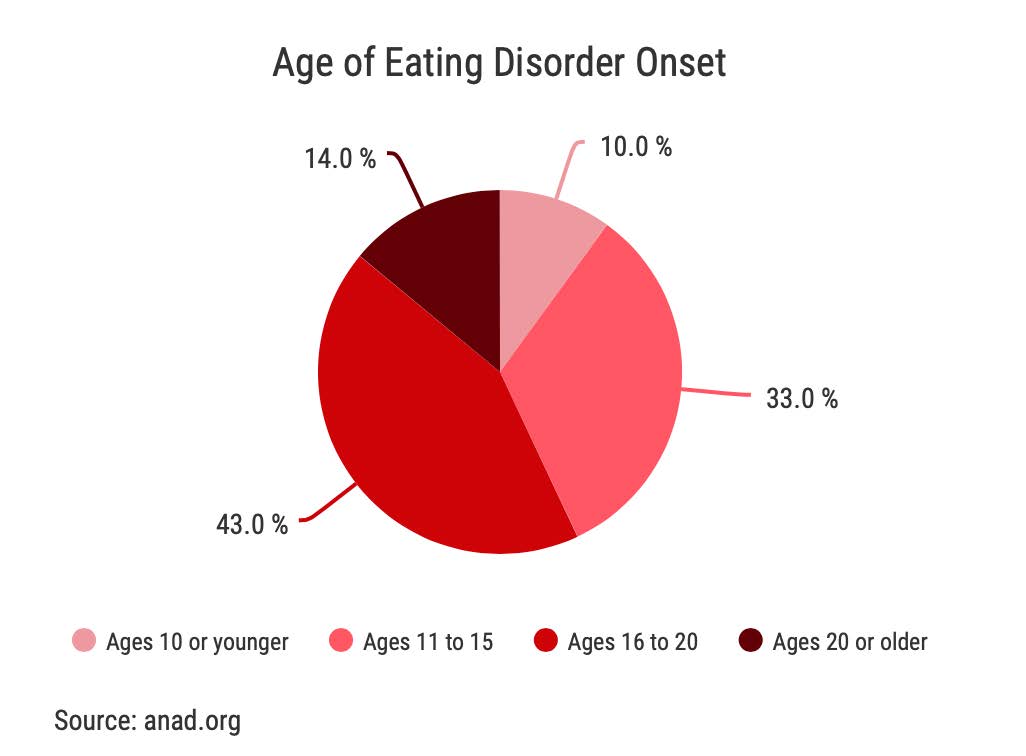Pictured Above: Data from ANAD shows that 43 percent of people with eating disorders are between the ages of 16 and 20 at the onset of the disorder.
Edyn Gottlieb | The Crow’s Nest
By Edyn Gottlieb
A major life change for many young people, the transition to university life presents a number of challenges for students. Among stresses of time management, academic success and social pressures, is some students’ damaging relationships with food and nutrition.
Eating disorders, according to Mayo Clinic, are “persistent eating behaviors” that create a negative impact on mental, physical and emotional health.
Eating disorders often stem from an unhealthy obsession with one’s weight, body shape and/or diet that results in dangerous eating habits. These unhealthy behaviors can limit the body’s ability to retain the appropriate nutrition, leading to serious health problems that can affect the heart, digestive system, bones, teeth and mouth, according to Mayo Clinic.
30 million people suffer from eating disorders in the U.S., according to the National Association of Anorexia Nervosa and Associated Disorders (ANAD), and the younger population is particularly at risk.
Eating disorders have the highest mortality rate of any mental illness according to ANAD.
The most common eating disorders are anorexia nervosa, bulimia nervosa and binge-eating disorder.
Anorexia nervosa, commonly known as anorexia, is defined as someone with an abnormally low body weight who has an intense fear of gaining weight and a skewed view of their body. It is a serious, potentially life-threatening disorder.
Bulimia nervosa, commonly referred to as bulimia, is defined as someone who experiences episodes of bingeing and purging and feels a lack of control surrounding their eating. The person may also engage in restrictive behaviors during the day leading to increased binge/purge episodes. It is also a potentially life-threatening disorder.
Binge-eating disorders are characterized as someone who regularly gorges on food (a binge) and feels a lack of control surrounding food. They may eat quickly and not stop when they are full, even when it leads to significant discomfort. After a binge the person may feel sad, embarrassed or guilty about their behavior, but they don’t engage in restriction or purging like with anorexia and bulimia.
According to the Multi Service Eating Disorder Association (MEDA), 95 percent of people with eating disorders are between 12 and 25.
MEDA also found that anorexia may affect up to 15 percent of people in their teens and 20s. It is the third most common chronic illness among adolescent females in the U.S..
While eating disorders are more common in females, Child Mind states that around 10 percent of people with anorexia and 40 percent of those with binge eating disorder are male.
So why are college age students so highly affected by eating disorders?
“College is a period of development in which disordered eating is likely to arise, resurface, or worsen for many young men and women,” National Eating Disorder Association (NEDA) CEO Claire Mysko told Healthline.
Mike Gurr, a licensed professional counselor and executive director at The Meadows Ranch Eating Disorder Treatment and Recovery Center, told Healthline that there are several reasons college students are more at risk for developing an eating disorder.
Around 40 percent of all incoming freshmen in college have had experience with disordered eating. Disordered eating, while not fully an eating disorder, is an indicator of an unhealthy relationship with food.
“And when you look at only females entering college, that number goes up to 80 percent,” Gurr said.
People who have experienced disordered eating or have an otherwise unhealthy relationship with food are at much higher risk of developing an eating disorder.
According to Gurr, the college transition can act as a catalyst in the progression of the development of an eating disorder.
“For starters, it’s a huge shift. And the people who struggle with eating disorders tend to have these temperaments where they struggle with change,” Gurr said in a Healthline interview.
Gurr explained that being in college usually means meeting and being exposed to new people which, for someone with preexisting disordered eating habits, can lead to unhealthy comparison.
“As we know, when we start comparing ourselves to others, we’re ultimately going to fall short,” Gurr said. “That’s when shame comes into play. And shame is the hallmark of any eating disorder. That’s why you see a prevalence in those college years.”
The college culture does little to promote a healthy-habits and can normalize disordered behaviors.
University life puts many students in an environment where well-balanced meals are a rarity and binge-eating and drinking are normalized. Ironically, studies have shown that diets and nutrition-focused ideas run rampant in college culture.
According to Veritas Collaborative, a comprehensive health care system for those with eating disorders, early detection of eating disorders can substantially help mitigate the long term effects these disorders can have on the body and brain.
Lack of proper nutrients can lead to malnutrition which can have a serious negative effect on bone density, brain development, reproductive health and the heart. Left untreated, these medical consequences can be irreversible and fatal.
“One of the ways we work with colleges and universities is by encouraging schools to promote NEDA’s free online screen tool which allows students to take a quick, anonymous self-assessment survey,” Mysko said in an interview with Healthline.
After taking the survey, if the student’s results indicate they might be at risk they have the option to speak to a counselor at the college or seek additional treatment through NEDA.
If you or anyone you know is struggling with an eating disorder, you can find support and services at the following resources:
** USF St. Petersburg Wellness Center
** National Eating Disorder Association (NEDA)
** National Association of Anorexia Nervosa and Associated Disorders (ANAD)



